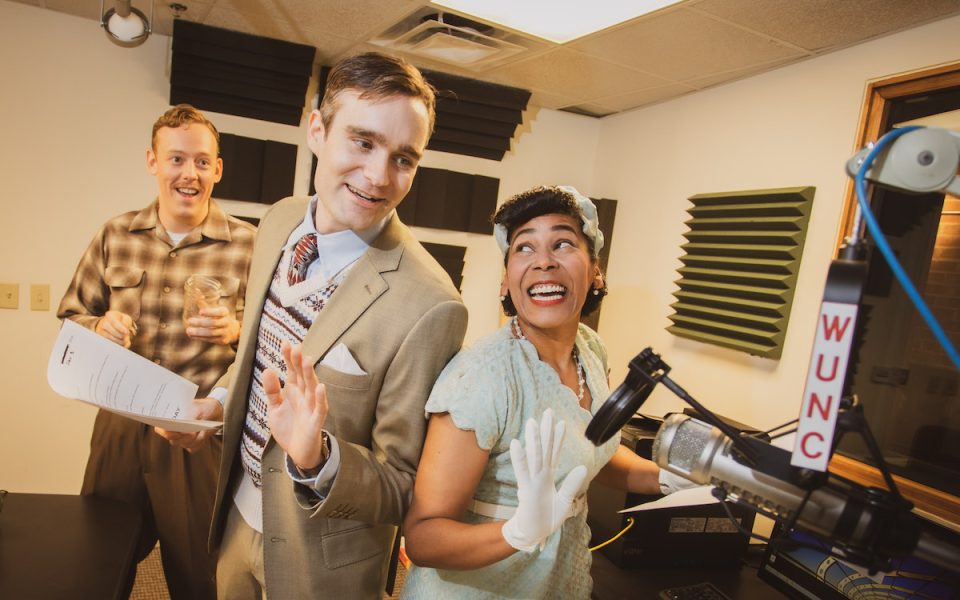Close your eyes.
Now imagine: It’s 1946, Christmas Eve. You’re cozying up by
the fire with your family. Out of the corner of your eye, you see the tinsel on
the tree catch light and twinkle. Someone turns the radio on. The static fades
away as the announcer sets the stage. Tonight, just in time for the big day,
your local radio station is broadcasting a live play of It’s a Wonderful
Life. You saw it last year at the movies, but it’s your first time hearing it
on the air.
Radio dramas took the country by storm throughout the 1930s
and ’40s, captivating listeners with just the sound of actors’ voices, music
and sound effects. Just a few years later, television would all but kill the
old family pastime. For this year’s holiday season, Triad Stage in Greensboro
brings back the beloved form of entertainment, this time setting it on stage,
giving viewers a firsthand experience of what producing a live radio play might
have looked like in the medium’s golden age. Just like the dramas that once
were, this rendition of the holiday cult classic relies heavily on expert voice
acting, musical score and even the incorporation of a live Foley artist, or a
sound effects artist.
“I’ve seen the movie many times,” says Ann Marie Costa, the
director of It’s a Wonderful Life: A Live Radio Play. “I grew up with
it. I thought the challenge was gonna be that the movie’s a classic — everyone
knows it. How are we going to do it in a different way that captures the movie
but gives justice to making it live?”
The adaptation is taken from playwright Joe Landry’s translation of the film to a live radio play. The stage looks like a mid-century radio station, properly equipped with old-school ribbon microphones, a backlit sign that reads “WBFR,” and two cues underneath that light up and read “On the air” and “Applause.” While the original film has dozens of actors to fill out the roles, in this adaptation, just five actors and the Foley artist bring the story to life.

The radio show host, Freddie Fillmore, introduces the story which plays out on stage as the handful of actors move from mic to mic, playing different characters to fill out the roles. The audience in the theater is essentially watching a play within a play. The stage actor who plays the voice actor who portrays Clarence the angel switches between playing the guardian angel and Harry Bailey, George’s little brother. As the story moves along, the actors recite lines to help the audience — the ones that would be listening through the radio that is — follow along by mentioning when an actor enters the scene. In another instance, actor Carlos Lopez fires off lines one after another, switching seamlessly between playing Mr. Potter, Uncle Billy, and the senior angel. In between acts, the actors come together to sing out live commercials for hair tonic and windshield soap, set to the tune of popular Christmas songs.
Despite the lack of set changes and the heavy reliance on sound to follow the story, the expertly executed voice acting by each of the five individuals on stage helps transport the viewers in the audience from scene to scene.
“There was a question of how the audience could find their
way into a work that’s so oral when we are such a visual society,” Costa says.
“But we knew that if we did it well, that the audience would enjoy going back
in time when everything was slowed down.”
Then of course, there’s the live Foley artist. Played by
Bradley Carter, he doesn’t have any lines in the show, but he may be one of the
most important actors on stage. Using an array of odd materials, Carter infuses
sound effects into the story in real time, adding to the immersion. He splashes
around in a bin full of water to create the sound of Clarence falling through the
water. A snapping belt becomes slaps across the face. A small, cut-out door and
clogs creates door slams and pronounced footsteps. Every sound aligns with the
actors’ lines, carrying the story forward, off the stage and into the would-be
listeners ears through the airwaves.
“It’s how the sounds would have been made in the 1940s,”
Costa says. “It’s very different than today where technology does all that.”
Costa says the combination of the live sound effects artist
as well as the versatility of each of the actors on stage helps to bring this
decades-old story new life.
They were also intentional about casting, bringing in a
younger actor to play Clarence and a black woman to play Mary, originally
played by Donna Reed.
And more than 70 years later, Costa says there’s a reason
the story remains a classic.
“What’s timeless about this piece is that we all have a purpose,” Costa says. “We have a significant place in our lifetime even if we don’t know what it is. The play is very heart based. It’s about caring for others…. I think it’s a very important message, especially in a time when we can be very individualistic.”
It’s a Wonderful Life: A Live Radio Play runs from Dec. 1 through Dec. 22. Find tickets and more info at triadstage.org.
Join the First Amendment Society, a membership that goes directly to funding TCB‘s newsroom.
We believe that reporting can save the world.
The TCB First Amendment Society recognizes the vital role of a free, unfettered press with a bundling of local experiences designed to build community, and unique engagements with our newsroom that will help you understand, and shape, local journalism’s critical role in uplifting the people in our cities.
All revenue goes directly into the newsroom as reporters’ salaries and freelance commissions.





Leave a Reply